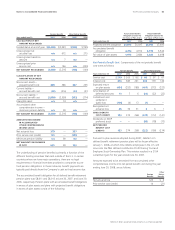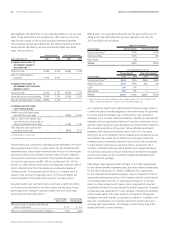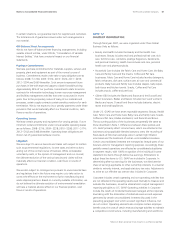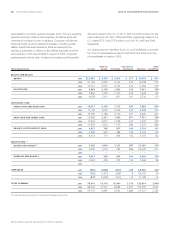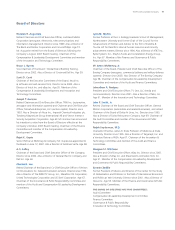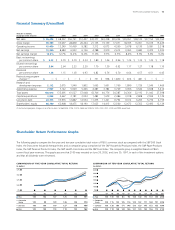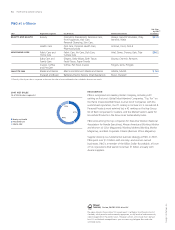Proctor and Gamble 2007 Annual Report Download - page 69
Download and view the complete annual report
Please find page 69 of the 2007 Proctor and Gamble annual report below. You can navigate through the pages in the report by either clicking on the pages listed below, or by using the keyword search tool below to find specific information within the annual report.Millions of dollars except per share amounts or as otherwise specied.
Notes to Consolidated Financial Statements The Procter & Gamble Company 67
In certain situations, we guarantee loans for suppliers and customers.
The total amount of guarantees issued under such arrangements is
not material.
We do not have off-balance sheet nancing arrangements, including
variable interest entities, under FIN 46, “Consolidation of Variable
Interest Entities,” that have a material impact on our nancial
statements.
We have purchase commitments for materials, supplies, services and
property, plant and equipment as part of the normal course of
business. Commitments made under take-or-pay obligations are as
follows: 2008 – $1,360; 2009 – $914; 2010 – $634; 2011 – $459;
2012 – $394 and $660 thereafter. Such amounts represent future
purchases in line with expected usage to obtain favorable pricing.
Approximately 44% of our purchase commitments relate to service
contracts for information technology, human resources management
and facilities management activities that were outsourced in recent
years. Due to the proprietary nature of many of our materials and
processes, certain supply contracts contain penalty provisions for early
termination. We do not expect to incur penalty payments under these
provisions that would materially affect our nancial condition, cash
ows or results of operations.
We lease certain property and equipment for varying periods. Future
minimum rental commitments under noncancelable operating leases
are as follows: 2008 – $316; 2009 – $238; 2010 – $208; 2011 – $174;
2012 – $102 and $408 thereafter. Operating lease obligations are
shown net of guaranteed sublease income.
We are subject to various lawsuits and claims with respect to matters
such as governmental regulations, income taxes and other actions
arising out of the normal course of business. While considerable
uncertainty exists, in the opinion of management and our counsel,
the ultimate resolution of the various lawsuits and claims will not
materially affect our nancial condition, cash ows or results of
operations.
We are also subject to contingencies pursuant to environmental laws
and regulations that in the future may require us to take action to
correct the effects on the environment of prior manufacturing and
waste disposal practices. Based on currently available information, we
do not believe the ultimate resolution of environmental remediation
will have a material adverse effect on our nancial position, cash
ows or results of operations.
NOTE 12
Through scal year 2007, we were organized under three Global
Business Units as follows:
Beauty and Health includes the Beauty and the Health Care
businesses. Beauty includes retail and professional hair care, skin
care, feminine care, cosmetics, prestige fragrances, deodorants,
and personal cleansing. Health Care includes oral care, personal
health care and pharmaceuticals.
Household Care includes the Fabric Care and Home Care, the Baby
Care and Family Care and the Snacks, Coffee and Pet Care
businesses. Fabric Care and Home Care includes laundry detergents,
fabric enhancers, dish care, surface care, air care and commercial
products. Baby Care and Family Care includes diapers, baby wipes,
bath tissue and kitchen towels. Snacks, Coffee and Pet Care
includes snacks, coffee and pet food.
Gillette GBU includes the Blades and Razors and the Duracell and
Braun businesses. Blades and Razors includes men’s and women’s
blades and razors. Duracell and Braun includes batteries, electric
razors and small appliances.
Under U.S. GAAP, we have seven reportable segments: Beauty; Health
Care; Fabric Care and Home Care; Baby Care and Family Care; Snacks,
Coffee and Pet Care; Blades and Razors; and Duracell and Braun.
The accounting policies of the businesses are generally the same as
those described in Note 1. Differences between these policies and
U.S. GAAP primarily reect: income taxes, which are reected in the
businesses using applicable blended statutory rates; the recording of
xed assets at historical exchange rates in certain high-ination
economies and the treatment of certain unconsolidated investees.
Certain unconsolidated investees are managed as integral parts of our
business units for management reporting purposes. Accordingly, these
partially owned operations are reected as consolidated subsidiaries
in segment results, with 100% recognition of the individual income
statement line items through before-tax earnings. Eliminations to
adjust these line items to U.S. GAAP are included in Corporate. In
determining after-tax earnings for the businesses, we eliminate the
share of earnings applicable to other ownership interests, in a manner
similar to minority interest, and apply statutory tax rates. Adjustments
to arrive at our effective tax rate are also included in Corporate.
Corporate includes certain operating and non-operating activities that
are not reected in the operating results used internally to measure and
evaluate the businesses, as well as eliminations to adjust management
reporting principles to U.S. GAAP. Operating activities in Corporate
include the results of incidental businesses managed at the corporate
level along with the elimination of individual revenues and expenses
generated by certain unconsolidated investees discussed in the
preceding paragraph over which we exert signicant inuence, but
do not control. Operating elements also comprise certain employee
benet costs, the costs of certain restructuring-type activities to maintain
a competitive cost structure, including manufacturing and workforce








